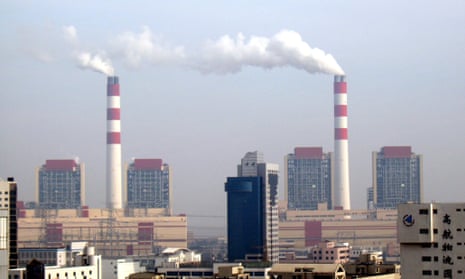China’s largest coal-fired power plant has been violating national emission standards for chemicals that cause dangerous fine particulate matter pollution, official figures show.
The Waigaoqiao coal-fired power plant located in Shanghai has been violating China’s national standards for nitrogen oxides every week since new standards came into force in July, according to analysis of publicly available government data by researchers at Greenpeace East Asia.
The data shows that phase two of the Waigaoqiao plant, which has a capacity of 1,800MW, has been emitting nitrogen oxides in excess of emission standards used by the local environmental protection bureau 18% of the time.
Research by Greenpeace also shows that the local regulator is not yet using the national standards on nitrogen oxides. If the new standards were being used, the group said the plant would be in violation almost all of the time.
Waigaoqiao is often praised as the cleanest coal-powered plant in China and is seen as a showcase for other plants in the country. However such a large violation of emissions standards at this plant shows that China is still struggling with enforcing its environmental protection laws and regulations.
“The gap in enforcement is still there,” said Ma Jun, the director of the Institute of Public and Environmental Affairs in Beijing, which also monitors pollution levels throughout China. The case shows that even in the well-developed coastal regions of China “there is still an enforcement gap, but the gap is bigger in the mid and western parts of China,” he said.
Lauri Myllyvirta, a senior global coal campaigner with Greenpeace, said: “the systematic violations, in a mega power plant in the middle of China’s most important economic centre and the failure by the regulator to effectively intervene illustrate the challenge that China faces in controlling emissions from its massive coal industry”.

Greenpeace also looked at figures for the neighbouring province of Jiangsu and found that in July, half of the coal-fired plants were violating the regulations on nitrogen oxides. “This is not a single case but maybe in the whole country the power plants have the same problem,” said Fang Lifeng, a coal expert with Greenpeace, based in Beijing.
Nitrogen oxides are one of the main contributors to fine particulate pollution known as PM2.5 which is considered dangerous because it penetrates deep into the lungs. PM2.5 pollution was linked to 670,000 premature deaths in 2012, according to a study released in November.
While China has made progress in dealing with other components of air pollution including sulphur dioxide, it has only recently started to deal with the issue of nitrogen oxides.
China is still facing many issues in terms of enforcement of its environmental regulations but there has been a lot of progress made on transparency of data and it is now publishing real-time data from a huge number of power and industrial plants.
“With this I think China has made some remarkable progress and we need to recognise that. The real-time disclosure of the online monitoring data on such a massive scale, China is probably the first country to do that,” said Ma Jun.
“It demonstrates that in China there has been some real political will to try to deal with the problems.”

Comments (…)
Sign in or create your Guardian account to join the discussion